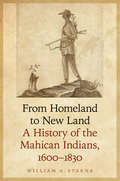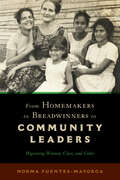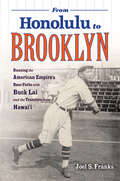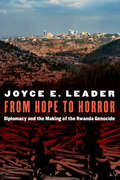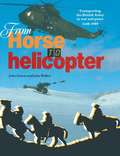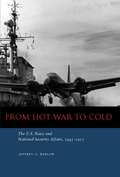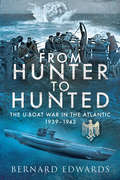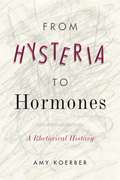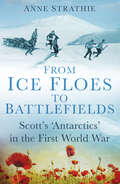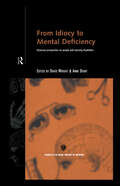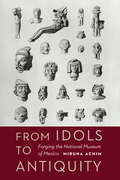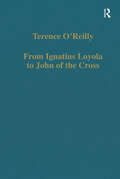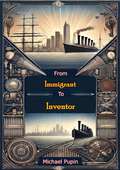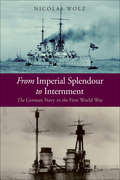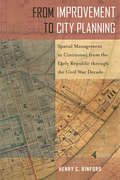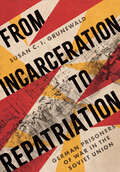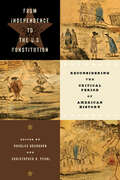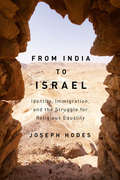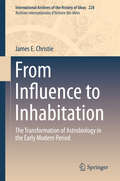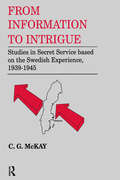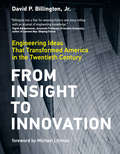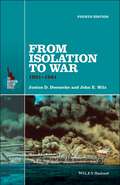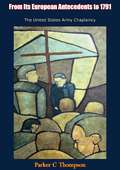- Table View
- List View
From Homeland to New Land: A History of the Mahican Indians, 1600-1830 (The Iroquoians and Their World)
by William A. StarnaThis history of the Mahicans begins with the appearance of Europeans on the Hudson River in 1609 and ends with the removal of these Native people to Wisconsin in the 1830s. Marshaling the methods of history, ethnology, and archaeology, William A. Starna describes as comprehensively as the sources allow the Mahicans while in their Hudson and Housatonic Valley homeland; after their consolidation at the praying town of Stockbridge, Massachusetts; and following their move to Oneida country in central New York at the end of the Revolution and their migration west.The emphasis throughout this book is on describing and placing into historical context Mahican relations with surrounding Native groups: the Munsees of the lower Hudson, eastern Iroquoians, and the St. Lawrence and New England Algonquians. Starna also examines the Mahicans&’ interactions with Dutch, English, and French interlopers. The first and most transformative of these encounters was with the Dutch and the trade in furs, which ushered in culture change and the loss of Mahican lands. The Dutch presence, along with the new economy, worked to unsettle political alliances in the region that, while leading to new alignments, often engendered rivalries and war. The result is an outstanding examination of the historical record that will become the definitive work on the Mahican people from the colonial period to the Removal Era.
From Homemakers to Breadwinners to Community Leaders: Migrating Women, Class, and Color
by Norma Fuentes-MayorgaIn From Homemakers to Breadwinners to Community Leaders, Norma Fuentes-Mayorga compares the immigration and integration experiences of Dominican and Mexican women in New York City, a traditional destination for Dominicans but a relatively new one for Mexicans. Her book documents the significance of women-led migration within an increasingly racialized context and underscores the contributions women make to their communities of origin and of settlement. Fuentes-Mayorga’s research is timely, especially against the backdrop of policy debates about the future of family reunification laws and the unprecedented immigration of women and minors from Latin America, many of whom seek human rights protection or to reunite with families in the US. From Homemakers to Breadwinners to Community Leaders provides a compelling look at the suffering of migrant mothers and the mourning of family separation, but also at the agency and contributions that women make with their imported human capital and remittances to the receiving and sending community. Ultimately the book contributes further understanding to the heterogeneity of Latin American immigration and highlights the social mobility of Afro-Caribbean and indigenous migrant women in New York.
From Hometown to Battlefield in the Civil War Era
by Timothy R. MahoneyMahoney examines how members of the middle class from small cities across the great West were transformed by boom and bust, years of recession, and civil war. He argues that in their encounters with national economic forces, the national crisis in politics, and the Civil War, middle class people were cut adrift from the social identity that they had established in the 'face to face' communities of the 'hometowns' of the urban West. By grounding them in their hometown ethos, and understanding how the Panic of 1857 and the subsequent recession undermined their lives, the author provides important insights into how they encountered, responded to, and were changed by their experiences in the Civil War. Providing a rare view of social history through the framework of the Civil War, the author documents, in both breadth and depth, the dramatic change and development of modern life in nineteenth-century America.
From Honolulu to Brooklyn: Running the American Empire’s Base Paths with Buck Lai and the Travelers from Hawai’i
by Joel S. FranksFrom 1912 to 1916, a group of baseball players from Hawaiʻ i barnstormed the U.S. mainland. While initially all Chinese, the Travelers became more multiethnic and multiracial with ballplayers possessing Chinese, Japanese, Hawaiian, and European ancestries. As a group and as individuals the Travelers' experiences represent a still much too marginalized facet of baseball and sport history. Arguably, they traveled more miles and played in more ball parks in the American empire than any other group of ballplayers of their time. Outside of the major leagues, they were likely the most famous nine of the 1910s, dominating their college opponents and more than holding their own against top-flight white and black independent teams. And once the Travelers’ journeys were done, a team leader and star Buck Lai gained fame in independent baseball on the East Coast of the U.S., while former teammates ran base paths and ran for political office as they confronted racism and colonialism in Hawaiʻ i.
From Hope to Horror: Diplomacy and the Making of the Rwanda Genocide
by Joyce E. LeaderAs deputy to the U.S. ambassador in Rwanda, Joyce E. Leader witnessed the tumultuous prelude to genocide—a period of political wrangling, human rights abuses, and many levels of ominous, ever-escalating violence. From Hope to Horror offers her insider&’s account of the nation&’s efforts to move toward democracy and peace and analyzes the challenges of conducting diplomacy in settings prone to—or engaged in—armed conflict. Leader traces the three-way struggle for control among Rwanda&’s ethnic and regional factions. Each sought to shape democratization and peacemaking to its own advantage. The United States, hoping to encourage a peaceful transition, midwifed negotiations toward an accord. The result: a revolutionary blueprint for political and military power-sharing among Rwanda&’s competing factions that met categorical rejection by the &“losers&” and a downward spiral into mass atrocities. Drawing on the Rwandan experience, Leader proposes ways diplomacy can more effectively avert the escalation of violence by identifying the unintended consequences of policies and emphasizing conflict prevention over crisis response. Compelling and expert, From Hope to Horror fills in the forgotten history of the diplomats who tried but failed to prevent a human rights catastrophe.
From Horse Power to Horsepower: 1890-1930
by Mike FileyFrom the 1890s through the 1920s, as horse gave way to machine, the look of Toronto and the lifestyles of its inhabitants were irrevocably altered. From Horse Power to Horsepower is a pictorial history of the vehicles of the era.
From Horse to Helicopter: Transporting the British Army in War and Peace 1648–1989
by John Walker John SuttonThis is a pictorial history of Army transportation. The book outlines the development of the three modes of transport used in supporting the British Army on land, in water and in air, from the horse to the helicopter. Both the authors are retired officers who served in the Royal Corps of Transport.
From Hot War to Cold
by Jeffrey G. BarlowThis book discusses the role of the U. S. Navy within the country's national security structure during the first decade of the Cold War from the perspective of the service's senior uniformed officer, the Chief of Naval Operations, and his staff. It examines a variety of important issues of the period, including the Army-Navy fight over unification that led to the creation of the National Security Act of 1947, the early postwar fighting in China between the Nationalists and the Communists, the formation of NATO, the outbreak of the Korean War, the decision of the Eisenhower Administration not to intervene in the Viet Minh troops' siege of the French garrison at Dien Bien Phu, and the initiation of the Eisenhower "New Look" defense policy. The author relies upon information obtained from a wide range of primary sources and personal interviews with important, senior Navy and Army officers. The result is a book that provides the reader with a new way of looking at these pivotal events.
From Hunter to Hunted: The U-Boat War in the Atlantic, 1939–1943
by Bernard EdwardsThe author of Churchill’s Thin Grey Line shares case histories from World War II’s Battle of the Atlantic featuring the German U-boat.In the early stages of World War II, Donitz’s U-boats generally adhered to Prize rules, surfacing before attacking and making every effort to preserve the lives of their victims’ crews. But, with the arming of merchantmen and greater risk of damage or worse, they increasingly attacked without warning.So successful was the U-boat campaign that Churchill saw it as the gravest threat the nation faced. The low point was the March 1943 attack on convoys SC122 and HX229 when 44 U-boats sank 22 loaded ships.The pendulum miraculously swung with improved tactics and technology. In May, 1943, out of a force of over 50 U-boats that challenged ONS5, eight were sunk and 18 were damaged, some seriously. Such losses were unsustainable, and, with allied yards turning out ships at ever increasing rates, Donitz withdrew his wolf packs from the North Atlantic.Expert naval author and historian Bernard Edwards traces the course of the battle of the Atlantic through a series of thrilling engagement case studies.Praise for From Hunter to Hunted “Expertly written, it portrayed the perils and dramas of warfare in the North Atlantic between the convoys and German U boats . . . Reading [Edwards’s] accounts made me feel as though I was present. A cracking and informative read— I will definitely read more by Captain Edwards and I highly commend it.” —Adrian Greaves, author of The Zulus at War
From Hysteria to Hormones: A Rhetorical History (RSA Series in Transdisciplinary Rhetoric #7)
by Amy KoerberIn From Hysteria to Hormones, Amy Koerber examines the rhetorical activity that preceded the early twentieth-century emergence of the word hormone and the impact of this word on expert understandings of women’s health.Shortly after Ernest Henry Starling coined the term “hormone” in 1905, hormones began to provide a chemical explanation for bodily phenomena that were previously understood in terms of “wandering wombs,” humors, energies, and balance. In this study, Koerber posits that the discovery of hormones was not so much a revolution as an exigency that required old ways of thinking to be twisted, reshaped, and transformed to fit more scientific turn-of-the-century expectations of medical practices. She engages with texts from a wide array of medical and social scientific subdisciplines; with material from medical archives, including patient charts, handwritten notes, and photographs from the Salpêtrière Hospital, where Dr. Jean Charcot treated hundreds of hysteria patients in the late nineteenth century; and with current rhetorical theoretical approaches to the study of health and medicine. In doing so, Koerber shows that the boundary between older, nonscientific ways of understanding women’s bodies and newer, scientific understandings is much murkier than we might expect.A clarifying examination of how the term “hormones” preserves key concepts that have framed our understanding of women’s bodies from ancient times to the present, this innovative book illuminates the ways in which the words we use today to discuss female reproductive health aren’t nearly as scientifically accurate or socially progressive as believed. Scholars of rhetoric, gender studies, and women’s health will find Koerber’s work provocative and valuable.
From Ice Floes to Battlefields: Scott’s ‘Antarctics’ in the First World War
by Anne StrathieFebruary 1912: Harry Pennell and his Terra Nova shipmates brave storms and ice to bring supplies to Antarctica. They hope to celebrate Captain Scott’s conquest of the South Pole, but are forced by ice to return north before Scott’s party returns. In New Zealand a reporter tells them that Roald Amundsen reached the Pole first. Returning to Antarctica in early 1913, they learn that Scott’s party reached the Pole but died on the ice shelf. Back in Britain memorial services, medal ceremonies, weddings and resumed careers are abruptly interrupted by the First World War. Fit and able men, Scott’s ‘Antarctics’ trade one adventure for another. By 1919 Scott’s ‘Antarctics’ have fought at Antwerp, the Western Front, Gallipoli, in the Channel, at Jutland and in Arctic Russia. They serve on horseback, in trenches, on battleships and hospital ships, in armoured cars and flimsy aircraft; their brothers-in-arms include a prime minister’s son and poet Rupert Brooke. As in Antarctica, life is challenging and dangerous. As on the ice, not all survive.
From Idiocy to Mental Deficiency: Historical Perspectives on People with Learning Disabilities (Routledge Studies in the Social History of Medicine)
by David Wright Anne DigbyFrom Idiocy to Mental Deficiency is the first book devoted to the social history of people with learning disabilities in Britain. Approaches to learning disabilities have changed dramatically in recent years. The implementation of 'Care in the Community', the campaign for disabled rights and the debate over the education of children with special needs have combined to make this one of the most controversial areas in social policy today. The nine original research essays collected here cover the social history of learning disability from the Middle Ages through the establishment of the National Health Service. They will not only contribute to a neglected field of social and medical history but also illuminate and inform current debates. The information presented here will have a profound impact on how professionals in mental health, psychiatric nursing, social work and disabled rights understand learning disability and society's responses to it over the course of history.
From Idols to Antiquity: Forging the National Museum of Mexico (The Mexican Experience)
by Miruna AchimFrom Idols to Antiquity explores the origins and tumultuous development of the National Museum of Mexico and the complicated histories of Mexican antiquities during the first half of the nineteenth century. Following independence from Spain, the National Museum of Mexico was founded in 1825 by presidential decree. Nationhood meant cultural as well as political independence, and the museum was expected to become a repository of national objects whose stories would provide the nation with an identity and teach its people to become citizens.Miruna Achim reconstructs the early years of the museum as an emerging object shaped by the logic and goals of historical actors who soon found themselves debating the origin of American civilizations, the nature of the American races, and the rightful ownership of antiquities. Achim also brings to life an array of fascinating characters—antiquarians, naturalists, artists, commercial agents, bureaucrats, diplomats, priests, customs officers, local guides, and academics on both sides of the Atlantic—who make visible the rifts and tensions intrinsic to the making of the Mexican nation and its cultural politics in the country’s postcolonial era.
From Ignatius Loyola to John of the Cross: Spirituality and Literature in Sixteenth-Century Spain (Variorum Collected Studies)
by Terence O'ReillyThe 16th century saw the rise of movements of religious reform which, in Spain as elsewhere, contributed to make the history of the period such a ferment. In these essays Terence O’Reilly is concerned with the writings produced by these movements, notably Illuminism, the early Jesuits, Erasmianism, and the Carmelite reform, and with the mixture of medieval and new literary conventions that they display. The book first deals with Ignatius Loyola and his Spiritual Exercises, examining its origins in his experience of conversion and the books he read, and locating him not in the period of the militant Counter-Reform, but in an earlier world, linked to the teachings of 16th Spanish Erasmians and illuminists. One study, hitherto unpublished, presents the lost treatise in which the Dominican Melchor Cano argued that Ignatius was an alumbrado. The following sections move to the later the century, considering the connections between spirituality and literature in works such as the ode to Salinas and, above all, in the mystical poetry of John of the Cross and its basis in exegesis and liturgical and devotional texts.
From Immigrant to Inventor: and Pioneer of Electrical Transmission and the Long-Distance Telephone Line
by Michael Idvorsky PupinFrom Immigrant to Inventor is the inspiring autobiography of Michael Idvorsky Pupin, chronicling his extraordinary journey from a modest childhood in rural Serbia to becoming a distinguished scientist, inventor, and professor in the United States. Originally published in 1923, the book offers a personal and reflective narrative of perseverance, intellectual discovery, and the immigrant experience during a transformative era in American history.Pupin begins with memories of his upbringing in a Serbian village, where curiosity about the natural world first sparked his lifelong passion for learning. He then recounts his emigration to the United States as a young man, arriving with little more than determination and dreams of an education. The narrative unfolds with his struggles to adapt to a new culture, working tirelessly to fund his studies and overcome the challenges of poverty.Central to the story is Pupin’s education at Columbia University and further scientific training in Europe, where he immersed himself in physics, mathematics, and engineering. The book traces his groundbreaking inventions in telecommunication and electrical transmission—work that played a pivotal role in advancing wireless communication and earning him numerous patents and accolades, including the Pulitzer Prize for this very memoir.Beyond recounting his personal achievements, Pupin reflects on the broader themes of science, innovation, and the opportunities available to immigrants in America. He emphasizes the importance of education, hard work, and resilience, inspiring readers with his belief that adversity can be a catalyst for greatness.A blend of memoir, science, and philosophy, From Immigrant to Inventor offers a timeless exploration of the immigrant spirit and the transformative power of knowledge. It is a compelling read for those interested in the history of technology, the immigrant experience, and the life of one of the most influential inventors of the 20th century.
From Imperial Splendour to Internment: The German Navy in the First World War
by Nicolas WolzThis important new work describes how the Imperial German Navy, which had expanded to become one of the great maritime forces in the world, second only to the Royal Navy, proved, with the exception of its submarines, to be largely ineffective throughout the years of conflict.The impact of this impotence had a far-reaching effect upon the service. Germany, indeed most of Europe, was in the grips of a spirit of militant nationalistic fervour, and the inactivity of the great Imperial Navy caused deep frustration, particularly among the naval officers. Not only were they unable to see themselves as heroes, they were also ridiculed on the home front and felt profoundly humiliated. With the exception of the one sea battle at Jutland, their ships saw little or no action at sea and morale slowly collapsed to a point where, at the end of the war, the crews were in a state of mutiny. The seemingly ludicrous order that forced the fleet to go to sea against the British in 1918 was driven by a sense of humiliation, but coming at the war's end it triggered a revolution because the German sailors wanted no part in such madness. The internment at Scapa Flow was the ultimate shaming. This is a fascinating and perceptive analysis of a whole era, and it contributes substantially to our understanding of the war and its consequences consequences, sadly, that helped pave the way for the Third Reich.
From Improvement to City Planning: Spatial Management in Cincinnati from the Early Republic through the Civil War Decade (Urban Life, Landscape and Policy)
by Henry C. BinfordFrom Improvement to City Planning emphasizes the ways people in nineteenth-century America managed urban growth. Historian Henry Binford shows how efforts to improve space were entwined with the evolution of urban governance (i.e., regulation)—and also influenced by a small group of advantaged families. Binford looks specifically at Cincinnati, Ohio, then the largest and most important interior city west of the Appalachian Mountains. He shows that it was not just industrialization, but also beliefs about morality, race, health, poverty, and “slum” environments, that demanded an improvement of urban space. As such, movements for public parks and large-scale sanitary engineering in the 1840s and ’50s initiated the beginning of modern city planning. However, there were limitations and consequences to these efforts.. Many Americans believed that remaking city environments could also remake citizens. From Improvement to City Planning examines how the experiences of city living in the early republic prompted city dwellers to think about and shape urban space.
From Incarceration to Repatriation: German Prisoners of War in the Soviet Union (Battlegrounds: Cornell Studies in Military History)
by Susan C. GrunewaldFrom Incarceration to Repatriation explores the lives and memories of the nearly 1.5 million German POWs who were held by the Soviet Union during and after World War II and released in phases through 1956, seven years longer than the prisoners of any other Allied nation. Susan C. I. Grunewald argues that Soviet leadership deliberately kept able-bodied German POWs to supplement their labor force after the end of the war. The Soviet Union lost 27 million citizens and a quarter of its physical assets during the war, motivating Soviet leadership to harness the labor of German POWs for as long as possible. Engaging with recently declassified documents in former Soviet archives, archival material from multiple German governments, as well as innovative use of digital humanities methods and geographic information system (GIS) mapping, Grunewald demonstrates that Soviet authorities detained German POWs primarily for economic rather than punitive reasons. In fact, the GIS mapping of the historical materials makes it clear that most of the four thousand POW camps across the USSR were strategically located near industrial, infrastructure, and natural resource sites that were critical to postwar economic reconstruction. From Incarceration to Repatriation is the first book to draw together the distinct fields of Soviet and German history to provide a more nuanced and comprehensive understanding of German POW captivity in the USSR during and after World War II. Attending to the ways that the memory of German POWs remains in circulation in both the former Soviet Union and Germany, Grunewald tracks the political repercussions of war commemoration.
From Independence to the U.S. Constitution: Reconsidering the Critical Period of American History (Early American Histories)
by Douglas Bradburn Christopher R. PearlThe "Critical Period" of American history—the years between the end of the American Revolution in 1783 and the ratification of the U.S. Constitution in 1789—was either the best of times or the worst of times. While some historians have celebrated the achievement of the Constitutional Convention, which, according to them, saved the Revolution, others have bemoaned that the Constitution’s framers destroyed the liberating tendencies of the Revolution, betrayed debtors, made a bargain with slavery, and handed the country over to the wealthy.This era—what John Fiske introduced in 1880 as America’s "Critical Period"—has rarely been separated from the U.S. Constitution and is therefore long overdue for a reevaluation on its own terms. How did the pre-Constitution, postindependence United States work? What were the possibilities, the tremendous opportunities for "future welfare or misery for mankind," in Fiske’s words, that were up for grabs in those years? The scholars in this volume pursue these questions in earnest, highlighting how the pivotal decade of the 1780s was critical or not, and for whom, in the newly independent United States.As the United States is experiencing another, ongoing crisis of governance, reexamining the various ways in which elites and common Americans alike imagined and constructed their new nation offers fresh insights into matters—from national identity and the place of slavery in a republic, to international commerce, to the very meaning of democracy—whose legacies reverberated through the nineteenth and twentieth centuries and into the present day.Contributors:Kevin Butterfield, Fred W. Smith National Library for the Study of George Washington at Mount Vernon * Hannah Farber, Columbia University * Johann N. Neem, Western Washington University * Dael A. Norwood, University of Delaware * Susan Gaunt Stearns, University of Mississippi * Nicholas P. Wood, Spring Hill College
From India to Israel: Identity, Immigration, and the Struggle for Religious Equality (McGill-Queen's Studies in the History of Religion #2)
by Joseph HodesBetween May 1948 and December 1951, Israel received approximately 684,000 immigrants from across the globe. The arrival of so many ethnic, linguistic, and cultural groups to such a small place in such a short time was unprecedented and the new country was ill-prepared to absorb its new citizens. The first years of the state were marked by war, agricultural failure, a housing crisis, health epidemics, a terrible culture clash, and a struggle between the religious authorities and the secular government over who was going to control the state. In From India to Israel, Joseph Hodes examines Israel's first decades through the perspective of an Indian Jewish community, the Bene Israel, who would go on to play an important role in the creation of the state. He describes how a community of relatively high status and free from persecution under the British Raj left the recently independent India for fear of losing status, only to encounter bias and prejudice in their new country. In 1960, a decision made by the religious authorities to ban the Bene Israel from marrying other Jews on the grounds that they were not "pure Jews" set in motion a civil rights struggle between the Indian community and the religious authority with far-reaching implications. After a drawn-out struggle, and under pressure from both the government and the people, the Bene Israel were declared acceptable for marriage. A detailed look at how one immigrant community fought to maintain their place within a religion and a society, From India to Israel raises important questions about the state of Israel and its earliest struggles to absorb the diversity in its midst.
From Influence to Inhabitation: The Transformation of Astrobiology in the Early Modern Period (International Archives of the History of Ideas Archives internationales d'histoire des idées #228)
by James E. ChristieThis book describes how and why the early modern period witnessed the marginalisation of astrology in Western natural philosophy, and the re-adoption of the cosmological view of the existence of a plurality of worlds in the universe, allowing the possibility of extraterrestrial life. Founded in the mid-1990s, the discipline of astrobiology combines the search for extraterrestrial life with the study of terrestrial biology – especially its origins, its evolution and its presence in extreme environments. This book offers a history of astrobiology's attempts to understand the nature of life in a larger cosmological context. Specifically, it describes the shift of early modern cosmology from a paradigm of celestial influence to one of celestial inhabitation. Although these trends are regarded as consequences of Copernican cosmology, and hallmarks of a modern world view, they are usually addressed separately in the historical literature. Unlike others, this book takes a broad approach that examines the relationship of the two. From Influence to Inhabitation will benefit both historians of astrology and historians of the extraterrestrial life debate, an audience which includes researchers and advanced students studying the history and philosophy of astrobiology. It will also appeal to historians of natural philosophy, science, astronomy and theology in the early modern period.
From Information to Intrigue: Studies in Secret Service Based on the Swedish Experience, 1939-1945 (Studies In Intelligence Ser.)
by C.G. McKayThis volume offers an account of some key activities of the Allied secret services and their German counterparts in Sweden during World War II. It also describes in some detail Swedish wartime legislation and Swedish organizations concerned with internal security and intelligence.
From Insight to Innovation: Engineering Ideas That Transformed America in the Twentieth Century
by David P. BillingtonThe engineering ideas behind key twentieth-century technical innovations, from great dams and highways to the jet engine, the transistor, the microchip, and the computer.Technology is essential to modern life, yet few of us are technology-literate enough to know much about the engineering that underpins it. In this book, David P. Billington, Jr., offers accessible accounts of the key twentieth-century engineering innovations that brought us into the twenty-first century. Billington examines a series of engineering advances--from Hoover Dam and jet engines to the transistor, the microchip, the computer, and the internet--and explains how they came about and how they work.
From Isolation to War: 1931-1941 (The American History Series #23)
by Justus D. Doenecke John E. WilzThe new edition of this popular and widely-used American history textbook has been thoroughly updated to include a wealth of new scholarship on American diplomacy in the decade leading up to Japan’s attack on Pearl Harbor. Features new material on the Washington Conference of 1921-22, early American diplomacy in the Manchurian crisis, the Panay incident, Russia’s invasion of Finland, the destroyer-bases deal, and much more Pays particular attention to Roosevelt’s policies towards Jewish refugees, the battle between domestic groups like the America First Committee and Fight for Freedom, and the Welles mission of 1940 Includes concise biographical sketches of major world leaders, including Hoover, FDR, Churchill, Hitler, Stalin, Mussolini, and Tojo Outlines and examines the debates of historians over the wisdom of U.S. policies
From Its European Antecedents to 1791 The United States Army Chaplaincy
by Parker C ThompsonThis volume is one of a series of five prepared by various authors, designed to be useful and instructive regarding the long history of the United States Army Chaplaincy. The emphasis throughout is on how chaplains did their ministry in the contexts of both war and peace. The series seeks to present as full and as balanced an account as limitations of space and research time permit. The bibliography in each volume offers opportunities for further research. The author of this volume is Chaplain Parker C. Thompson, a Regular Army chaplain of the Southern Baptist Convention. He is a native of Missouri, and entered on active duty as a chaplain in 1952. He has served at Camp Atterbury, Indiana; Fort Leonard Wood, Missouri; Fort Knox, Kentucky; US Army Chaplain Center and School, Fort Hamilton, New York; Fort Dix, New Jersey; and overseas in Korea, Germany, and Vietnam. He has been awarded the Legion of Merit, the Bronze Star Medal (Valor) with 2 Oak Leaf Clusters, the Meritorious Service Medal, the Air Medal, the Army Commendation Medal with 1 Oak Leaf Cluster, and the Purple Heart with 1 Oak Leaf Cluster.
